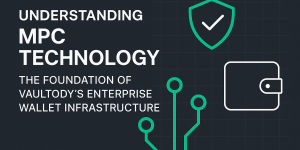Mitigating Custody Risk: An Enterprise Guide to Protecting Crypto Assets

What is custody risk — and why enterprises must care
Custody risk is the danger of losing access to your organization’s digital assets because the private keys are stolen, compromised, or mismanaged. Private keys allow owners of the vaults to obtain full control over cryptocurrency and tokenized assets. Lose them, and the funds are gone — permanently.
For enterprises, this is more than a technical security concern. It’s a strategic business risk. The fallout from a custody breach can include multi-million dollar losses, lawsuits, regulatory penalties, operational downtime, and reputational damage that takes years to repair.
By early 2025, market research indicates that an estimated 2.3 to 3.7 million Bitcoins have been lost forever, effectively removing them from circulation. That equates to roughly 11–18% of Bitcoin’s hard-capped supply of 21 million coins, with some studies placing the figure closer to 4 million BTC. These dormant coins have a major impact on Bitcoin’s real availability. Although about 19.8 million BTC have been mined to date, the number actively accessible for trading or spending is likely between 15.8 and 17.5 million BTC. This hidden scarcity tightens supply without changing Bitcoin’s maximum limit, reinforcing its deflationary nature.
Why custody risk is an enterprise-level problem
Enterprises, project teams, and institutional investors face a higher baseline of risk compared to individual holders:
- Larger balances make them prime targets for sophisticated attackers.
- Multiple stakeholders introduce complexity in access control and approval workflows.
- Legal and compliance obligations require assets to be managed in line with regulatory frameworks.
- Operational interdependencies mean custody failures can halt entire business functions, delay transactions, or breach contractual obligations.
High-profile cases like the collapse of major exchanges and large-scale wallet breaches prove one thing: custody failures happen fast and often without warning. For a business or fund, the impact goes far beyond the immediate loss — it can derail financing rounds, trigger investor lawsuits, and destroy market credibility.
Where organizations are most exposed
Custody risk takes different forms, but for enterprises, four categories stand out:
1. Security threats
While external hacking attempts remain a concern, the use of Multi-Party Computation (MPC) hosted solely by the client can introduce new security vulnerabilities. Internal parties with access to the system may pose risks, potentially compromising parts of the private key.
Vaultody’s innovative approach allows a portion or several parts of the private key to be securely hosted with the client, while the other part remains protected within Vaultody’s infrastructure. This split-key architecture eliminates single points of failure, effectively mitigating both external cyber threats and internal risks. By distributing control, Vaultody ensures robust security that protects enterprises from insider threats and sophisticated attacks alike.
2. Operational & human error
Not all losses come from criminals. Mistakes such as sending assets to the wrong wallet address, misconfiguring permissions, or losing backup keys can be just as damaging. Without structured operational processes, even well-meaning staff can cause irreversible losses.
Enterprises are especially vulnerable when a single person holds excessive control or when there’s no clear recovery process if key staff leave or become unavailable.
3. Counterparty & insolvency risk
If a business relies on a third-party custodian or exchange to store assets, it also inherits that party’s risks. A custodian’s insolvency, mismanagement, or fraudulent activity can result in assets being frozen or lost. In some cases, even segregated accounts have been mishandled or used without authorization.
4. Regulatory & compliance risk
Crypto custody operates in a fast-changing regulatory environment. Inconsistent laws between jurisdictions, new licensing requirements, and tighter compliance obligations can force operational changes or cause assets to be locked until rules are met. For businesses with global operations, this creates an ongoing legal challenge.
Enterprise-grade controls that reduce custody risk
The best defense for an organization is a layered approach combining advanced technology, sound governance, and strong operational discipline.
Technical controls
- Multi-Party Computation (MPC): Splits the signing process into cryptographic shares stored across different locations or devices. No single person or system ever holds the complete private key, significantly reducing insider and external attack risks. Vaultody enhances this further by distributing MPC shares across multiple cloud providers—each share is stored on a separate cloud environment—to maximize security and eliminate single points of failure.
- Hardware Security Modules (HSMs) & Secure Enclaves: Physically protected, tamper-resistant devices that securely store and manage private keys, further safeguarding sensitive cryptographic material from physical and digital attacks.
- Vaultody Approver Mobile Application: Adds an extra layer of security by requiring transaction approvals through a dedicated mobile app, enabling real-time, secure multi-factor authentication and user verification. This ensures that only authorized parties can authorize transactions, strengthening operational control.
Operational & governance controls
- Segregation of duties: No single person should have full transaction authority.
- Dual control & approval workflows: All high-value movements should require sign-off from multiple authorized parties.
- Regular reconciliations & audits: Detect discrepancies early before they escalate.
- Insurance coverage: Crypto-specific insurance can offset losses, though it should be viewed as a complement, not a replacement, for robust security.
- Clear incident response plans: Predefined steps for handling suspected breaches, including asset freezing and key rotation.
Choosing a Custody Partner: Why Vaultody Stands Out for Enterprises
Selecting the right custody provider is critical for organizations managing digital assets. Vaultody offers a comprehensive suite of features tailored specifically to meet the complex demands of enterprises, project managers, and venture capital firms. Here’s why Vaultody is the ideal partner for secure, flexible, and compliant crypto custody:
- Flexible Integration Options: Unified and easy API integration with existing enterprise systems for seamless onboarding and management.
- Multiple Custody Models: Supports custody, co-custody, and non-custody frameworks to match any organizational need or regulatory requirement.
- Enterprise-Grade Security Mechanisms: Combines MPC with distributed cloud storage, Hardware Security Modules (HSMs), and secure enclaves to protect private keys at every level.
- Vaultody Approver Mobile App: Adds a secure, real-time transaction approval layer.
- Granular Role-Based Access Control: Full flexibility to assign distinct roles and permissions to team members, ensuring strict operational governance and internal controls.
- Multi-Cloud MPC Architecture: Cryptographic shares stored across multiple cloud providers, eliminating single points of failure and enhancing resilience.
- Business Continuity & Recovery Plans: Robust failover systems and procedures to ensure uninterrupted access and rapid recovery in emergencies.
- Scalable for Growth: Designed to support the expanding needs of institutional clients, from startups to large-scale funds and VCs.
- User-Friendly Interface: Intuitive dashboards and management tools designed to reduce operational complexity without compromising security.
- Dedicated Support & Onboarding: Expert guidance from Vaultody’s team to tailor the custody solution and ensure smooth adoption.
Quick operational checklist for businesses
Three actions your enterprise can take this quarter to strengthen custody:
- Enforce Dual Control for Critical Transactions
Require multiple authorized approvals before executing any high-value or sensitive transfers to minimize risks of unauthorized access or fraud.
- Adopt Advanced Security Measures
Utilize robust technical controls such as multi-signature wallets, multi-party computation (MPC), and hardware security modules (HSMs) to safeguard private keys and transaction processes.
- Leverage Automated Monitoring Tools
Set up allow lists to restrict destination addresses and enable real-time alerts for unusual or suspicious activities, ensuring immediate response to potential threats.
Why Custody Risk Belongs in the Boardroom
Custody risk is more than a technical issue—it’s a top business priority. It affects investor trust, fundraising, and your company’s future. Project managers, VCs, and executives must all treat custody as a critical part of their operations and strategy.
A custody breach can cause irreversible damage. That’s why strong security, clear governance, and trusted providers are essential to protect your assets and reputation.
Vaultody offers the solution. Using advanced technology like Multi-Party Computation (MPC), secure hardware, and flexible approval workflows, Vaultody secures your crypto assets safe, compliant, and easy to manage.
Whether you’re handling millions or building a blockchain project, Vaultody provides reliable protection without slowing you down. In crypto, there’s no second chance—Vaultody helps you avoid the first mistake which may bring fatal consequences to your business.




 Login
Login







 Copy link
Copy link